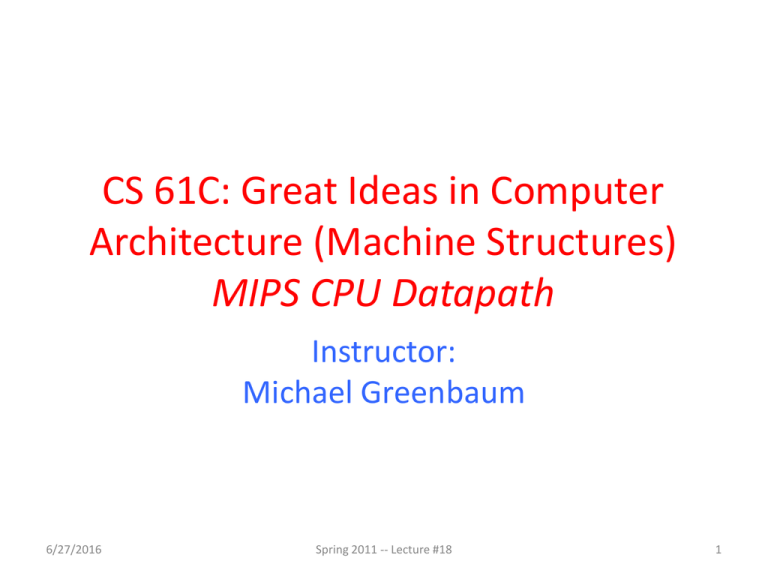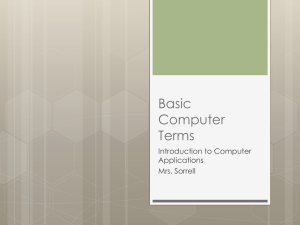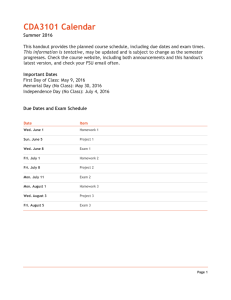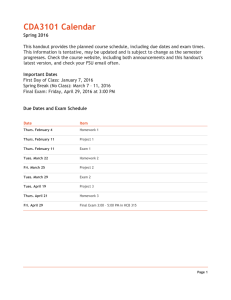CS 61C: Great Ideas in Computer Architecture (Machine Structures) MIPS CPU Datapath Instructor:
advertisement

CS 61C: Great Ideas in Computer
Architecture (Machine Structures)
MIPS CPU Datapath
Instructor:
Michael Greenbaum
6/27/2016
Spring 2011 -- Lecture #18
1
Levels of
Representation/Interpretation
High Level Language
Program (e.g., C)
Compiler
Assembly Language
Program (e.g., MIPS)
Assembler
Machine Language
Program (MIPS)
temp = v[k];
v[k] = v[k+1];
v[k+1] = temp;
lw
lw
sw
sw
0000
1010
1100
0101
$t0, 0($2)
$t1, 4($2)
$t1, 0($2)
$t0, 4($2)
1001
1111
0110
1000
1100
0101
1010
0000
Anything can be represented
as a number,
i.e., data or instructions
0110
1000
1111
1001
1010
0000
0101
1100
1111
1001
1000
0110
0101
1100
0000
1010
1000
0110
1001
1111
Machine
Interpretation
Hardware Architecture Description
(e.g., block diagrams)
Architecture
Implementation
Logic Circuit Description
(Circuit Schematic Diagrams)Spring 2011 -- Lecture #18
6/27/2016
2
Review
• D-Flip-Flops update output at rising edge of
clock
– Setup and Hold times important
• Critical Path constrains clock rate.
• Finite State Machines extremely useful
• Use muxes to select among input
– S input bits selects 2S inputs
– Each input can be n-bits wide, independent of S
• Build n-bit adder out of chained 1-bit adders.
6/27/2016
Spring 2011 -- Lecture #18
3
Review: N x 1-bit Adders 1 N-bit
Adder
Connect Carry Out i-1 to Carry in i:
b0
+
6/27/2016
+
Summer 2011 -- Lecture #24
+
4
What about detecting overflow?
• Unsigned overflow - The carry out from the most
significant bit.
• Signed overflow - A bit more complicated, two cases:
• Overflow from adding “big” positive numbers.
• Overflow from adding “big” negative numbers.
6/27/2016
Spring 2011 -- Lecture #18
5
Detecting Signed Overflow (4-bit examples)
• From two positive numbers:
• 0111 + 0111, 0111 + 0001, 0100 + 0100.
• What do these have in common? Carry-out from
the second highest bit (but not highest bit)
• From two negative numbers:
• 1000 + 1000, 1000 + 1111, 1011 + 1011.
• These have carry-out from the highest bit (but not
second highest bit)
• Expression for signed overflow: Cn XOR Cn-1
6/27/2016
Spring 2011 -- Lecture #18
6
Twos Complement Adder/Subtractor
Can subtract by adding the negative of the second number. To negate:
Flip the
bits
And add one!
6/27/2016
Summer 2011 -- Lecture #24
7
Agenda
•
•
•
•
5 Stages of the Datapath
Administrivia
Quick Datapath Walkthrough
Processor Design Process
– Determine datapath requirements based on
instruction set
– Select datapath components
– Assemble the datapath
6/27/2016
Spring 2011 -- Lecture #18
8
Five Components of a Computer
•
•
•
•
•
6/27/2016
Spring 2010 -- Lecture #9
Control
Datapath
Memory
Input
Output
9
The Processor
• Processor (CPU): Implements the instructions
of the Instruction Set Architecture (ISA)
• Datapath: portion of the processor which
contains hardware necessary to perform
operations required by the processor (the
brawn)
• Control: portion of the processor (also in
hardware) which tells the datapath what
needs to be done (the brain)
6/27/2016
Spring 2010 -- Lecture #9
10
Stages of the Datapath : Overview
• Break up the process of “executing an
instruction” into stages or phases, and then
connect the phases to create the whole datapath
– Smaller phases are easier to design
– Easy to optimize (change) one phase without touching
the others
• Project 1 had 3 phases: Fetch, Decode, Execute.
Here, we expand Execute into ALU, Memory
Access, and Register Write.
6/27/2016
Spring 2010 -- Lecture #9
11
Phases of the Datapath (1/5)
• Phase 1: Instruction Fetch
– No matter what the instruction, the 32-bit
instruction word must first be fetched from
memory (the cache-memory hierarchy)
– Also, this is where we Increment PC
(that is, PC = PC + 4, to point to the next
instruction: byte addressing so + 4)
6/27/2016
Spring 2010 -- Lecture #9
12
Phases of the Datapath (2/5)
31
26
op
6 bits
21
rs
5 bits
16
rt
5 bits
11
6
0
rd
shamt
funct
5 bits
5 bits
6 bits
• Phase 2: Instruction Decode
– Upon fetching the instruction, we next gather data
from the fields (decode all necessary instruction data)
– Read the opcode and each of the possible fields from
the 32 bits of the instruction.
– Read data from all necessary registers (This differs
from Project 1)
• For add, read two registers
• For addi, read one register
• For jal, no reads necessary
6/27/2016
Spring 2010 -- Lecture #9
13
Phases of the Datapath (3/5)
• Phase 3: ALU (Arithmetic-Logic Unit)
– Real work of most instructions is done here:
arithmetic (+, -, *, /), shifting, logic (&, |),
comparisons (slt)
– What about loads and stores?
• eg, lw $t0, 40($t1)
• Memory Address = Offset + Value in $t1
• We perform this addition in this stage.
6/27/2016
Spring 2010 -- Lecture #9
14
Phases of the Datapath (4/5)
• Phase 4: Memory Access
– Only the load and store instructions do anything
during this phase; the others remain idle or skip
this phase all together
– Since these instructions have a unique step, we
need this extra phase to account for them
– As a result of the cache system, this phase is
expected to be fast
6/27/2016
Spring 2010 -- Lecture #9
15
Phases of the Datapath (5/5)
• Phase 5: Register Write
– Most instructions write the result of some
computation into a register
– E.g.,: arithmetic, logical, shifts, loads, slt, jal(!)
– What about stores, branches, jumps?
• Don’t write anything into a register at the end
• These remain idle during this fifth phase or skip it all
together
6/27/2016
Spring 2010 -- Lecture #9
16
Why Five Stages?
• Could we have a different number of stages?
– Yes, and other architectures do
• So why does MIPS have five if instructions
tend to idle for at least one stage?
– The five stages are the union of all the operations
needed by all the instructions.
– There is one instruction that uses all five stages:
the load
+4
1. Instruction
Fetch
ALU
Data
memory
rd
rs
rt
registers
PC
instruction
memory
Generic Steps of Datapath
imm
2. Decode/
Register
Read
3. Execute
4. Memory
5. Reg.
Write
Agenda
•
•
•
•
5 Stages of the Datapath
Administrivia
Quick Datapath Walkthrough
Processor Design Process
– Determine datapath requirements based on
instruction set
– Select datapath components
– Assemble the datapath
6/27/2016
Spring 2011 -- Lecture #18
19
Administrivia
• HW3 Due Wednesday at midnight
– Should be able to answer last two questions after
today’s lecture.
• Project 2 Part 2 due Sunday.
• Lab 11 posted.
• Lab 12 cancelled!
– Replaced with free study session where you can
catch up on labs / work on project 2.
– The TA’s will still be there.
6/27/2016
Spring 2011 -- Lecture #18
20
cs61c in…Minecraft!
• Person builds 16-bit ALU in Minecraft.
• Let’s check out the video…
6/27/2016
Spring 2011 -- Lecture #18
21
Agenda
•
•
•
•
5 Stages of the Datapath
Administrivia
Quick Datapath Walkthrough
Processor Design Process
– Determine datapath requirements based on
instruction set
– Select datapath components
– Assemble the datapath
6/27/2016
Spring 2011 -- Lecture #18
22
Datapath Walkthroughs (1/3)
• add
$3,$1,$2 # R[3] = R[1]+R[2]
– Stage 1: fetch this instruction, inc. PC
– Stage 2: decode to find it’s an add, then read
registers $1 and $2
– Stage 3: add the two values retrieved in Stage 2
– Stage 4: idle (nothing to write to memory)
– Stage 5: write result of Stage 3 into register $3
+4
2
imm
add $3, $1, $2
reg[2]
reg[1]+reg[2]
ALU
Data
memory
3
1
reg[1]
registers
PC
instruction
memory
Example: add Instruction
Datapath Walkthroughs (2/3)
• slti
$3,$1,17
– Stage 1: fetch this instruction, inc. PC
– Stage 2: decode to find it’s an slti, then read register
$1
– Stage 3: compare value retrieved in Stage 2 with the
integer 17
– Stage 4: idle
– Stage 5: write the result of Stage 3 in register $3
+4
3
imm
slti $3, $1, 17
17
reg[1]
reg[1]<17?
ALU
Data
memory
x
1
registers
PC
instruction
memory
Example: slti Instruction
Datapath Walkthroughs (3/3)
• sw
$3, 17($1)
– Stage 1: fetch this instruction, inc. PC
– Stage 2: decode to find it’s a sw, then read
registers $1 and $3
– Stage 3: add 17 to value in register $1 (retrieved in
Stage 2)
– Stage 4: write value in register $3 (retrieved in
Stage 2) into memory address computed in Stage 3
– Stage 5: idle (nothing to write into a register)
+4
3
imm
reg[1]
reg[3]
reg[1]+17
ALU
Data
memory
x
1
registers
PC
instruction
memory
Example: sw Instruction
17
SW $3, 17($1)
MEM[$1+17]=$3
Agenda
•
•
•
•
5 Stages of the Datapath
Administrivia
Quick Datapath Walkthrough
Processor Design Process
– Determine datapath requirements based on
instruction set
– Select datapath components
– Assemble the datapath
6/27/2016
Spring 2011 -- Lecture #18
29
Processor Design Process
• Five steps to design a processor:
Step 1: Analyze instruction set to determine datapath
requirements
Step 2: Select set of datapath components & establish
clocking methodology
Step 3: Assemble datapath components to meet the
requirements
Step 4: Analyze implementation of each instruction to
determine setting of control points that realizes the
register transfer
Step 5: Assemble the control logic
6/27/2016
Spring 2011 -- Lecture #18
30
Processor Design Process
• Five steps to design a processor:
Step 1: Analyze instruction set to determine datapath
requirements
Step 2: Select set of datapath components & establish
clocking methodology
Step 3: Assemble datapath components to meet the
requirements
Step 4: Analyze implementation of each instruction to
determine setting of control points that realizes the
register transfer
Step 5: Assemble the control logic
6/27/2016
Spring 2011 -- Lecture #18
31
Step 1a: The MIPS-lite Subset for today
• ADDU and SUBU
31
op
– addu rd,rs,rt
– subu rd,rs,rt
• OR Immediate:
26
rs
6 bits
31
op
31
– lw rt,rs,imm16
– sw rt,rs,imm16
• BRANCH:
31
26
op
– beq rs,rt,imm16 6 bits
6/27/2016
5 bits
Spring 2011 -- Lecture #18
rd
shamt
funct
5 bits
5 bits
6 bits
0
16 bits
0
immediate
5 bits
21
rs
0
16
rt
5 bits
6
immediate
5 bits
21
rs
11
16
rt
5 bits
26
6 bits
5 bits
21
rs
op
16
rt
5 bits
26
– ori rt,rs,imm16 6 bits
• LOAD and
STORE Word
21
16 bits
16
rt
5 bits
0
immediate
16 bits
32
Register Transfer Language (RTL)
• RTL gives the meaning of the instructions
{op , rs , rt , rd , shamt , funct} MEM[ PC ]
Instruction Fetches
{op , rs , rt ,
Imm16} MEM[ PC ]
Inst
Register Transfers
ADDU
R[rd] R[rs] + R[rt]; PC PC + 4
SUBU
R[rd] R[rs] – R[rt]; PC PC + 4
ORI
R[rt] R[rs] | zero_ext(Imm16); PC PC + 4
LOAD
R[rt] MEM[ R[rs] + sign_ext(Imm16)]; PC PC + 4
STORE
MEM[ R[rs] + sign_ext(Imm16) ] R[rt]; PC PC + 4
BEQ
if ( R[rs] == R[rt] )
then PC PC + 4
(sign_ext(Imm16) || 00)
else PC PC + 4
6/27/2016
Spring 2011 -- Lecture #18
33
Step 1b: Requirements of the
Instruction Set
• Memory (MEM)
– Instructions & data (will use one for each: really caches)
• Registers (R: 32 x 32)
– Read rs
– Read rt
– Write rt or rd
• PC
• Extender (sign/zero extend)
• Add/Sub/OR unit for operation on register(s) or extended
immediate
• Add 4 (+ maybe extended immediate) to PC
• Compare if registers equal?
6/27/2016
Spring 2011 -- Lecture #18
34
Step 2: Components of the Datapath
• Combinational Elements
OP
CarryIn
A
A
Sum
CarryOut
32
Adder
B
32
32
Y
B
32
Multiplexer
32
ALU
32
A
MUX
Adder
B
32
Select
32
Result
32
ALU
• Storage Elements (Registers, Memory)
6/27/2016
Spring 2011 -- Lecture #18
35
Required ALU Operations
• Addition, subtraction, logical OR, ==:
ADDU
SUBU
ORI
R[rd] = R[rs] + R[rt]; ...
R[rd] = R[rs] – R[rt]; ...
R[rt] = R[rs] | zero_ext(Imm16)...
BEQ
if ( R[rs] == R[rt] )...
• Test to see if output == 0 for any ALU operation
gives == test. How?
• Full MIPS also adds AND, Set Less Than (1 if A < B,
0 otherwise)
• ALU from Appendix C, section C.5
6/27/2016
Spring 2011 -- Lecture #18
36
Storage Element: Idealized Memory
Write Enable
Address
• Memory (idealized)
– One input bus: Data In
– One output bus: Data Out
• Memory word is found by:
Data In
32
Clk
DataOut
32
– Address selects the word to put on Data Out
– Write Enable = 1: address selects the memory
word to be written via the Data In bus
• Clock input (CLK)
– CLK input is a factor ONLY during write operation
– During read operation, behaves as a combinational logic
block:
• Address valid Data Out valid after “access time”
6/27/2016
Spring 2011 -- Lecture #18
37
Storage Element: Register (Building Block)
Write Enable
• Similar to D Flip Flop except
– N-bit input and output
– Write Enable input
• Write Enable:
Data In
Data Out
N
N
clk
– Negated (or deasserted) (0): Data Out will not
change
– Asserted (1): Data Out will become Data In on
rising edge of clock
6/27/2016
Spring 2011 -- Lecture #18
38
Storage Element: Register File
RW RA RB
Write Enable 5 5 5
• Register File consists of 32 registers:
– Two 32-bit output busses:
busA and busB
– One 32-bit input bus: busW
• Register is selected by:
busW
32
Clk
32 x 32-bit
Registers
busA
32
busB
32
– RA (number) selects the register to put on busA (data)
– RB (number) selects the register to put on busB (data)
– RW (number) selects the register to be written
via busW (data) when Write Enable is 1
• Clock input (clk)
– Clk input is a factor ONLY during write operation
– During read operation, behaves as a combinational logic block:
• RA or RB valid busA or busB valid after “access time.”
6/27/2016
Spring 2011 -- Lecture #18
39
Clocking Methodology (1/2)
• Single Cycle CPU: All stages of an instruction
are completed within one long clock cycle.
– The clock cycle is made sufficient long to allow
each instruction to complete all stages without
interruption and within one cycle.
1. Instruction
Fetch
2. Decode/
Register
Read
3. Execute
4. Memory
• This is what we’ll talk about today.
5. Reg.
Write
Clocking Methodology (2/2)
• Multiple-cycle CPU: Only one stage of instruction
per clock cycle.
– The clock is made as long as the slowest stage.
1. Instruction
Fetch
2. Decode/
Register
Read
3. Execute
4. Memory
5. Reg.
Write
– Several significant advantages over single cycle
execution: Unused stages in a particular
instruction can be skipped OR instructions can
be pipelined (overlapped).
Step 3: Assemble Datapath Meeting
Requirements
Register Transfer Requirements Assembly of Datapath
• In common between all
instructions:
– Fetch the Instruction:
clk
mem[PC]
– Update the program counter:
• Sequential Code:
PC PC + 4
• Branch and Jump:
PC “something else”
6/27/2016
Spring 2011 -- Lecture #18
PC
Next Address
Logic
Address
Instruction Word
Instruction
Memory
32
42
Add & Subtract
• R[rd] = R[rs] op R[rt] (addu rd,rs,rt)
– Ra, Rb, and Rw come from instruction’s Rs, Rt, and Rd fields
31
26
op
6 bits
21
rs
5 bits
16
rt
5 bits
11
rd
5 bits
6
shamt
5 bits
0
funct
6 bits
– ALUctr and RegWr: control logic after decoding the instruction
rd rs rt
RegWr 5 5 5
Rw Ra Rb
32 x 32-bit
Registers
busA
32
busB
clk
ALU
busW
32
ALUctr
Result
32
32
• … Already defined the register file & ALU
6/27/2016
Spring 2011 -- Lecture #18
43
Logical Operations with Immediate
• R[rt] = R[rs] op ZeroExt[imm16]
31
26
21
op
16 15
rs
31 6 bits
0
rt
5 bits
immediate
5 bits 16 15
16 bits
0
immediate
0000000000000000
16 bits
16 bits
But we’re writing to Rt register??
ALUctr
RegWr Rd Rs Rt
5
Rw
busW
5
Ra Rb
6/27/2016
busA
32
ALU
RegFile
clk
5
busB
32
32
Spring 2011 -- Lecture #18
44
Logical Operations with Immediate
• R[rt] = R[rs] op ZeroExt[imm16]
31
26
21
op
rd
rt
1
0
RegWr
5
Rw
rs
5 bits
5
rt
immediate
5 bits 16 15
busA
32
ZeroExt
16
0
immediate
16 bits
32
ALU
busB
clk
imm16
16 bits
ALUctr
5
Ra Rb
0
rt
0000000000000000
16 bits
RegFile
32
6/27/2016
rs
31 6 bits
RegDst
16
0
32
• Already defined
32-bit MUX;
Zero Ext?
1
32
ALUSrc
Spring 2011 -- Lecture #18
45
Load Operations
• R[rt] = Mem[R[rs] + SignExt[imm16]]
Example: lw rt,rs,imm16
31
26
21
op
16
rs
6 bits
0
rt
5 bits
immediate
5 bits
16 bits
RegDst rd rt
1
RegWr
0
5
Rw
5
ALUctr
5
Ra Rb
busA
32
clk
imm16
16
32
ALU
busB
ZeroExt
6/27/2016
rt
RegFile
32
What sign
extending??
rs
32
0
1
32
Spring 2011 -- Lecture #18
ALUSrc
46
Load Operations
• R[rt] = Mem[R[rs] + SignExt[imm16]]
Example: lw rt,rs,imm16
31
26
21
op
16
rs
6 bits
0
rt
5 bits
immediate
5 bits
16 bits
ALUctr
RegDst rd rt
1
RegWr
0
rs
5
5
Rw
busW
5
Ra Rb
busA
16
ExtOp
Extender
imm16
32
ALU
busB
32
clk
6/27/2016
rt
RegFile
32
MemtoReg
MemWr
32
0
0
1
? 32
Data In
ALUSrc
clk
32
Spring 2011 -- Lecture #18
WrEn Adr
Data
Memory
1
47
Store Operations
• Mem[ R[rs] + SignExt[imm16] ] = R[rt]
Ex.: sw rt, rs, imm16
31
op
26
21
16
rs
5 bits
6 bits
rt
5 bits
immediate
16 bits
ALUctr
RegDst Rd Rt
1
RegWr
0
5
5
5
busA
busB
32
imm16
16
ExtOp
Extender
clk
32
0
ALU
RegFile
32
MemtoReg
MemWr
Rs Rt
Rw Ra Rb
busW
0
32
0
32 WrEn Adr
1
32
Data In
ALUSrc clk
Data
Memory
1
Store Operations
• Mem[ R[rs] + SignExt[imm16] ] = R[rt]
Ex.: sw rt, rs, imm16
31
op
26
21
16
rs
5 bits
6 bits
rt
5 bits
immediate
16 bits
ALUctr
RegDst Rd Rt
1
RegWr
0
5
5
5
busA
busB
32
imm16
16
ExtOp
Extender
clk
32
0
ALU
RegFile
32
MemtoReg
MemWr
Rs Rt
Rw Ra Rb
busW
0
32
0
32 WrEn Adr
1
32
Data In
ALUSrc clk
Data
Memory
1
The Branch Instruction
31
26
op
6 bits
21
rs
5 bits
16
rt
5 bits
immediate
16 bits
beq rs, rt, imm16
– mem[PC] Fetch the instruction from memory
– Zero = R[rs] - R[rt] Calculate branch condition
– if (Zero) Calculate the next instruction’s address
• PC = PC + 4 + ( SignExt(imm16) x 4 )
else
• PC = PC + 4
0
Datapath for Branch Operations
• beq rs, rt, imm16
Datapath generates condition (zero)
31
op
26
21
rs
6 bits 5 bits
Inst Address
immediate
16 bits
00
busW
clk
5
ALUctr
Rs Rt
5
5
Rw Ra Rb
busA
RegFile
busB
32
z
ALU
PC
clk
0
Zero
RegWr
Mux
Adder
PC Ext
imm16
rt
5 bits
nPC_sel
Adder
4
16
32
32
Already have mux, adder, need special sign extender for
PC, need equal compare (sub?)
Putting it All Together: A Single Cycle Datapath
RegDst
32
0
5
5
5
Rw Ra Rb
RegFile
busA
busB
32
16
Extender
imm16
MemtoReg
MemWr
Rs Rt
clk
clk
ALUctr
Zero
32
z
ALU
busW
PC
PC Ext
Adder
Mux
00
RegWr
Adder
4
Rt Rd Imm16
Rd Rt
1
Instruction<31:0>
<0:15>
nPC_sel
Rs
<11:15>
Adr
<16:20>
<21:25>
Inst
Memory
0
32
1
32
Data In
clk
imm16
ExtOp
ALUSrc
32
0
WrEn Adr
Data
Memory
1
An Abstract View of the Implementation
Ideal
Instruction
Memory
PC
clk
32
Instruction
Rd Rs Rt
5 5
5
Rw Ra Rb
Register
File
clk
Control Signals Conditions
A
32
ALU
Next Address
Instruction
Address
Control
B
32
32
Datapath
Data
Addr
Data
Ideal
Out
Data
Memory
Data
In clk





